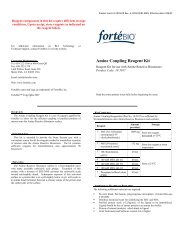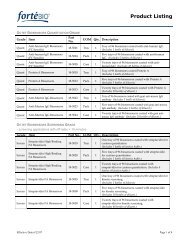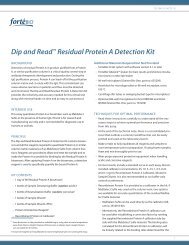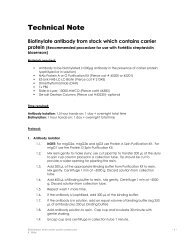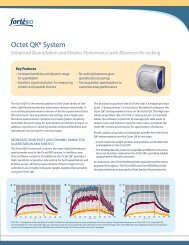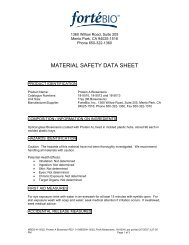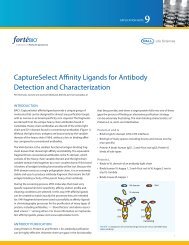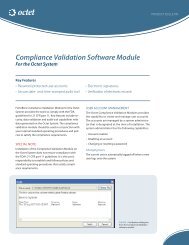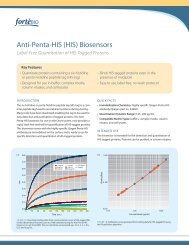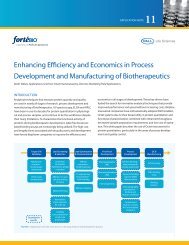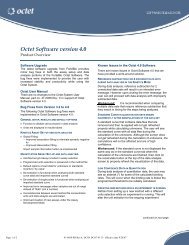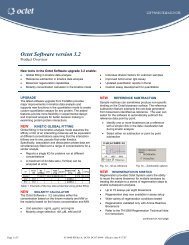Regeneration Strategies for Streptavidin Biosensors on ... - ForteBio
Regeneration Strategies for Streptavidin Biosensors on ... - ForteBio
Regeneration Strategies for Streptavidin Biosensors on ... - ForteBio
- No tags were found...
Create successful ePaper yourself
Turn your PDF publications into a flip-book with our unique Google optimized e-Paper software.
Technical Note 16nm5.004.504.003.503.002.502.001.501.000.500.000 200 400 600 800 1,000 1,200 1,400 1,600 1,800 2,000 2,200 2,400 2,600 2,800 3,000 3,200 3,400 3,600 3,800 4,000 4,200T ime (sec)A1 B1 C1 D1 E1 F1 G1 H1Figure 5: Real time results from regenerati<strong>on</strong> scouting and validati<strong>on</strong> experiment run <strong>on</strong> the Octet RED instrument. Data shown is from 8 <str<strong>on</strong>g>Streptavidin</str<strong>on</strong>g> biosensors with biotinproteinA immobilized, binding human IgG and taken through regenerati<strong>on</strong> with 8 different reagents over 11 binding cycles..Assay SetupThe sample plate was set up as shown in Figure 4 and run <strong>on</strong> theOctet System using the assay method shown in Table 3.Assay ResultsIn Figure 5, the real time binding chart <str<strong>on</strong>g>for</str<strong>on</strong>g> the assay shows significantdifferences in the effectiveness of the eight regenerati<strong>on</strong>soluti<strong>on</strong>s across the eleven binding cycles tested. Only the acidicc<strong>on</strong>diti<strong>on</strong>s (sensors E1–H1) appear to show reas<strong>on</strong>able regenerati<strong>on</strong>of the binding capacity after the first binding cycle.Using the Data Analysis software, the successive binding cycles fromeach sensor can easily be overlaid (Figure 6A–H). The best regenerati<strong>on</strong>c<strong>on</strong>diti<strong>on</strong>s are quickly assessed by determining the level of IgGbinding <str<strong>on</strong>g>for</str<strong>on</strong>g> biosensors across all binding cycles. In this example, theNaCl, SDS and basic regenerati<strong>on</strong> soluti<strong>on</strong>s all show poor regenerati<strong>on</strong>as is evident by the clear loss of the amount of hIgG bindingABCDEnmnmFnmnmnmGnmnmHnmBindingCycle1234567891011Figure 6: Analysis of effectiveness of eight different reagents in regenerating Protein A immobilized to <str<strong>on</strong>g>Streptavidin</str<strong>on</strong>g> biosensors. Reagents tested were: A) 5 M NaCl; B) 0.01%SDS; C) NaOH, pH 10; D) NaOH, pH 11; E) HCln pH 0.5; F) 10 mM Glycine pH 1; G) 10 mM glycine, pH 2; H) 500 mM phosphoric acid5




